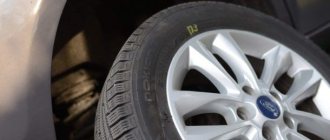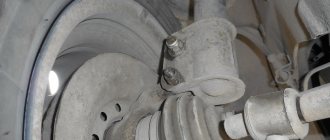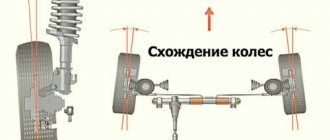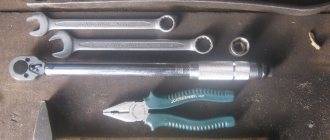Many drivers, when changing tires from summer to winter and vice versa, think about whether they need to do an alignment after changing the wheels and rely on the opinion of more experienced drivers or servicemen.
But many, especially inexperienced car owners, when changing tires, listen to all kinds of advisers who claim that it is necessary to do a wheel alignment when replacing tires or wheels. Is it really?
Is it necessary to do a wheel alignment after changing tires?
In general, wheel alignment is not necessary after replacing the front tires. The only procedure that is necessary here is wheel balancing. Installing other tires of the same size does not affect the wheel alignment angles. However, there are several cases when this procedure must be performed:
- Old tires show signs of one type of wear. This most likely indicates that the positional settings of the drive wheels were violated during the operation of the car. And to avoid similar wear on new tires, you need to go to the wheel alignment stand.
- Tires of a different diameter were installed. In this case, due to a change in the distance from the axis of rotation of the wheels to the point of contact with the road, a slight deviation of the camber from the preset norm may appear.
- The tires were replaced after an impact that damaged the cord or bent the wheel rim. Strong dynamic loads on the suspension often lead to deviation of the pre-installation angles of the wheels from the norm. Therefore, you can do a wheel alignment after changing tires in such situations. You also need to additionally check the caster (the angle of inclination of the stand relative to the vertical axis). To do this, you need to contact a tire shop, where this procedure is carried out on a modern automated stand with a laser coordinate system.
- Simultaneously with the replacement of tires, any repair or adjustment work was carried out in the suspension or steering.
- The suspension has not been tested on the stand for a long time. Replacing tires is a convenient time to adjust wheel alignment.
Car owners often think about the question: how often do they need to do a wheel alignment? Ideally, experts recommend visiting the stand to check wheel alignment angles twice a year during the change of seasons: in late autumn before the onset of cold weather and in spring after the snow melts.
Also read our autoblog about how much it costs to replace an engine.
This is interesting: How much oil is in the Niva Chevrolet gearbox
How to get rid of the hum of the front wheels when turning
This phenomenon is most often observed in vehicles with power steering. In this case, the hum can appear at different speeds: on some cars it can be heard already at 40 km, on others - at 70. The noise may appear when turning the steering wheel, but the vehicle itself will stand still at this moment.
To establish the cause of the noise, it is necessary to diagnose the performance of the components that affect the control system. If they are the problem, then there will be noise both when moving and when stopping. When noise occurs when cornering, it may vary. For example, when turning left, be present, but when turning right, disappear completely.
The principle of operation of silent blocks
Silent blocks are rubber-metal hinges that are the connecting element of the chassis system. They dampen the vibrations that occur, preventing their spread, and also give a certain degree of freedom to the parts connected to each other. This is one of the most important elements of a car’s suspension, requiring replacement if it malfunctions. The silent block consists of three parts: two metal bushings and a rubber or polyurethane gasket between them.
The exact mounting locations of silent blocks and their number are selected depending on the design of a particular car model. These elements are located on the front and rear axles. On the front axle, silent blocks are installed in the places where the lever connects to the hub and to the body, as well as at the attachment points of the anti-roll bar. On the rear axle, the places where silent blocks are placed are the levers and the attachment points for the torsion beam and shock absorbers. In addition, silent blocks can connect the steering rack with rods, as well as the body with the gearbox and engine.
The service life of silent blocks is usually 100 thousand km, but in bad road conditions this resource can be significantly reduced. After this, the silent block needs to be replaced. If extraneous noise appears in the chassis while driving, if there is a noticeable deterioration in the vehicle's handling, as well as in the case of typical tire wear and wheel play, you will most likely have to resort to repairs. In this regard, many people have a question: is it necessary to adjust the wheel alignment after repair? Let's try to understand this issue.
We recommend
“Computer diagnostics of a car engine: when is it needed and how is it carried out” Read more
What does incorrect wheel alignment lead to?
Everything is simple, if this parameter is disabled, then:
- The trajectory of the car is incorrect; it will pull to the right or to the left. Which is no longer safe.
- Increased tire wear on the wheel will require replacement more often.
- Incorrect position of the steering wheel in the car, which is also inconvenient.
To be honest, this is dangerous primarily due to the trajectory of movement, if at low speeds in the city you can hardly notice it, but at speeds of 60 km/h, the car may already be “wobbling” in different directions, that is, the steering wheel, you are holding straight - and the car is walking along the road. Well, the wear on the wheel will be simply enormous; even new tires can be ruined in a season.
Tire wear
Another reason that can be called quite common is the car spontaneously moving to the side when driving due to uneven wear of the tires. If your car uses tires (or one of the tires) that have previously been used somewhere, it is possible that the tires will have different wear.
In this situation, you need to carefully inspect the tires located on the side of the car towards which it tilts while driving. Look at the tire tread pattern; it may be a little more worn than on other wheels.
How to understand that the car is driving
On a flat road, having accelerated to 90 km/h and making sure that there are no other cars, simply let go of the steering wheel and look at the behavior of the car. If the car veers sharply to the left or right, then go to a car service center on the first free day. If the car smoothly moves to the right, then this is normal, because... there is a slope of the road .
If you steer the car to the left and the car moves smoothly to the left, then there is probably nothing wrong with the car and the alignment.
If the car still pulls to the right, and you steer to the left, but the car still steers to the right, then again there are 2 options:
- or it is necessary to do a wheel alignment;
- or crooked wheels.
In the first option, everything is clear, you need to go for diagnostics, change worn suspension elements and do a wheel alignment.
If you swapped the front wheels and the car began to pull to the left, but before that it was to the right, then the tires are to blame - 99%.
If the car drives straight, doesn’t rattle and doesn’t eat tires, then there’s no need to go to the wheel alignment after replacing the tires or wheels!
Let's start with the theoretical basics - when do you need to change tires?
You need to switch from summer to winter tires when the average daily air temperature drops below +10 degrees Celsius. The first frosts begin outside and summer tires begin to “tan,” i.e. becomes less elastic and loses its performance properties, since it is made from a rubber compound not intended for low temperatures. You may not take into account that the road surface takes longer to warm up than the air, and thereby provoke troubles on the road by “changing your shoes” too late.
Accordingly, you need to change back from winter to summer tires when the average daily air temperature rises to +10 degrees Celsius. At positive temperatures, winter tires will become excessively “soft,” increasing the car’s response time to driver actions, including braking, and also wear out faster. But, in general, it’s better to change a set of wheels for the winter earlier and “change your shoes” back later, thus protecting yourself from the “surprises” of the weather in the form of cold snaps and precipitation, which it likes to pamper us with lately.
You don’t have to worry about your tires - if you change them a week or two later, nothing bad will happen, but in this way you can protect yourself from unpleasant situations on the road.
The car pulls to the side after changing tires: reasons
If, after changing tires, the car begins to behave inappropriately, this is a consequence of incorrect settings of the elements of the car’s chassis. Usually the reason that the vehicle pulls to the side after replacing the ramps is one of these factors.
- Incorrect pressure. When installing new tires, car enthusiasts often forget about the need to check the tire inflation. If the car starts to drive crookedly, one of the tires may be flat.
- Tires installed incorrectly. Each slope has an inner and an outer side. There is a clear signpost for directional models. If the wheels on the same axle are positioned differently, the steering wheel will pull.
- Uneven wear. On the right side there is a good version, on the left there is a “dead” ramp, naturally the car will pull to the side.
- Problems with the brake mechanism. When replacing wheels, you can accidentally break the brake line, which will lead to the part jamming.
- Broken wheel alignment. The old tire could have gotten used to it and not react to the wearability violation.
After changing tires, the car pulls to the right when you let go of the steering wheel: what to do?
If the steering wheel moves to the right after changing tires, it is necessary to check the primary causes.
- Correct inflation - there should be equal pressure all around.
- Correct tire installation. Some craftsmen may mix up the wheels during installation.
- Brake system. A wedging caliper blocks the disc, which leads to slip.
- Uneven wear on the slopes. It is tedious to measure the tread depth with a caliper - it should be the same.
- Wheel alignment. Broken rods can cause the vehicle to roll away.
The importance of timely adjustment of suspension elements and balancing
The correct position of the chassis provides comfort to the car owner during trips. An unbalanced and incorrectly positioned suspension leads to unwanted vibration, which not only causes discomfort to the driver, but also accelerates wear on the wheels and tires. All this together can lead to an accident.
Correct setting of angles and timely balancing will lead to:
- increasing vehicle stability;
- improved handling;
- reducing the likelihood of skidding;
- fuel economy;
- reducing tire wear.
That is why the driver needs to pay more attention to the location of the wheels and monitor their balance after each manipulation associated with them (for example, re-adjusting or installing new tires).











